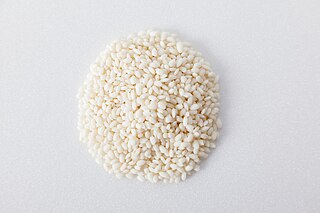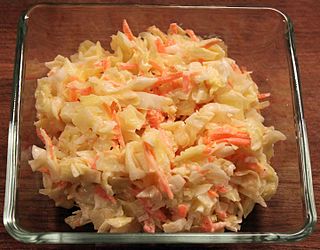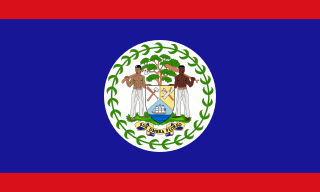Related Research Articles

Glutinous rice is a type of rice grown mainly in Southeast and East Asia, and the northeastern regions of South Asia, which has opaque grains, very low amylose content, and is especially sticky when cooked. It is widely consumed across Asia.

Polish cuisine is a style of cooking and food preparation originating in or widely popular in Poland. Due to Poland's history, Polish cuisine has evolved over the centuries to be very eclectic, and it shares many similarities with other regional cuisines. Polish-styled cooking in other cultures is often referred to as à la polonaise.

A grater, also known as a shredder, is a kitchen utensil used to grate foods into fine pieces.

Coleslaw, also known as cole slaw, or simply as slaw, is a side dish consisting primarily of finely shredded raw cabbage with a salad dressing or condiment, commonly either vinaigrette or mayonnaise. This dish originated in the Netherlands in the 18th century. Coleslaw prepared with vinaigrette may benefit from the long lifespan granted by pickling.

Barfi or burfi is a milk-based sweet from the Indian subcontinent with a fudge-like consistency. Its name comes from the Persian and Urdu word (barf) for snow. Barfi is consumed throughout India and Pakistan and is especially popular in North India. It is often served at celebrations and religious festivals such as Diwali and Holi.

Kūlolo is a Hawaiian dessert made primarily with baked or steamed grated taro corms and either with grated coconut meat or coconut milk. Considered a pudding, kūlolo has a solid consistency like fudge and is often served cut into squares. Its consistency is also described as chewy and lumpy like tapioca, and it tastes similar to caramel.

Puto is a Filipino steamed rice cake, traditionally made from slightly fermented rice dough (galapong). It is eaten as is or as an accompaniment to a number of savoury dishes. Puto is also an umbrella term for various kinds of indigenous steamed cakes, including those made without rice. It is a sub-type of kakanin.

Coconut candy refer to various candies made with coconut or coconut flavorings.

Laing, is a Filipino dish of shredded or whole taro leaves with meat or seafood cooked in thick coconut milk spiced with labuyo chili, lemongrass, garlic, shallots, ginger, and shrimp paste. It originates from the Bicol Region, where it is known simply as pinangat. Laing is also a type of ginataan, and thus may also be referred to as ginataang laing. Laing is commonly eaten as a vegetable side to complement meat or fish side dishes known as ulam in Filipino, which is normally paired with boiled white rice.

Belizean cuisine is an amalgamation of all ethnicities in the nation of Belize and their respectively wide variety of foods. Breakfast often consists of sides of bread, flour tortillas, or fry jacks that are often homemade and eaten with various cheeses. All are often accompanied with refried beans, cheeses, and various forms of eggs, etc. Inclusive is also cereal along with milk, coffee, or tea.

Serabi (ꦱꦼꦫꦧꦶ), surabi (ᮞᮥᮛᮘᮤ), or srabi (ᬲ᭄ᬭᬩᬶ) is a traditional Balinese–Javanese snack, similar to a pancake, made of a rice flour-based batter with coconut milk or coconut cream and shredded coconut as an emulsifier. Most traditional serabi tastes sweet, as these pancake-like desserts are usually eaten with kinca (ᮊᮤᮑ᮪ᮎ), a golden-brown coconut sugar syrup in the Sundanese culinary tradition.

Botok or ꦧꦺꦴꦛꦺꦴꦏ꧀(Bothok) is a traditional Javanese dish made from grated coconut flesh which has been squeezed of its coconut milk, often mixed with other ingredients such as vegetables or fish, and wrapped in banana leaf and steamed. It is commonly found in Javanese people area of Java Island (Yogyakarta Special Region, Central, and East Java. It has a soft texture like the mozzarella cheese, and is usually colored white.

Cocada are a traditional coconut confectionery found in many parts of Latin America. They are particularly popular in Argentina, Bolivia, Brazil, Colombia, Chile, the Dominican Republic, Cuba, Mexico, Panama, Venezuela and Ecuador. They are oven baked but are served at room temperature to provide their chewy and soft texture. Made with eggs and shredded coconut, cocadas come in a variety of colors due to the modern use of food coloring, however the traditional variations are golden brown. They are often garnished with almonds, either whole or chopped. There are hundreds of cocadas recipes, from the typical hard, very sweet balls to cocadas that are almost the creamy texture of flan. Other fruit, often dried, can be added to the cocadas to create variety, which will also lend to a wide spectrum of cocada colors. Cocadas are mentioned as early as 1878 in Peru.

Serundeng refers to a spicy grated coconut side dish or condiment, to accompany rice in Indonesian language. Serundeng may taste sweet, or hot and spicy according to recipe variants.

Malaysian Indian cuisine, or the cooking of the ethnic Indian communities in Malaysia, consists of adaptations of authentic dishes from India, as well as original creations inspired by the diverse food culture of Malaysia. Because the vast majority of Malaysia's Indian community are of South Indian descent, and are mostly ethnic Tamils who are descendants of immigrants from a historical region which consists of the modern Indian state of Tamil Nadu and Sri Lanka's Northern Province, much of Malaysian Indian cuisine is predominantly South Indian inspired in character and taste. A typical Malaysian Indian dish is likely to be redolent with curry leaves, whole and powdered spice, and contains fresh coconut in various forms. Ghee is still widely used for cooking, although vegetable oils and refined palm oils are now commonplace in home kitchens. Before a meal it is customary to wash hands as cutlery is often not used while eating, with the exception of a serving spoon for each respective dish.
Binatog, also known as bualaw or kinulti, is a Filipino boiled corn dessert topped with freshly grated coconut, butter, and salt or sugar. It is commonly sold as street food in the northern Philippines by vendors known as magbibinatog carrying characteristic large tin cans, similar to taho vendors.
Kulawo is a Filipino salad made with either minced banana blossoms or grilled eggplants cooked in coconut milk that is distinctively extracted from grated coconut meat toasted on live coals. It is a pre-colonial dish that originates from the provinces of Laguna and Quezon. Kulawo is a type of kilawin and ginataan. It is fully vegan and has a unique smoky taste that has been compared to smoked meat or fish dishes.
References
- ↑ Penny Loafers & Bobby Pins: Tales and Tips from Growing Up in the ’50s and ’60s (Google eBook) Susan Sanvidge, Diane Sanvidge Seckar, Jean Sanvidge Wouters, Julie Sanvidge Florence Wisconsin Historical Society, Sep 3, 2013 - Biography & Autobiography - 251 pages page 78
- ↑ Oh Fudge!: A Celebration of America's Favorite Candy page 83